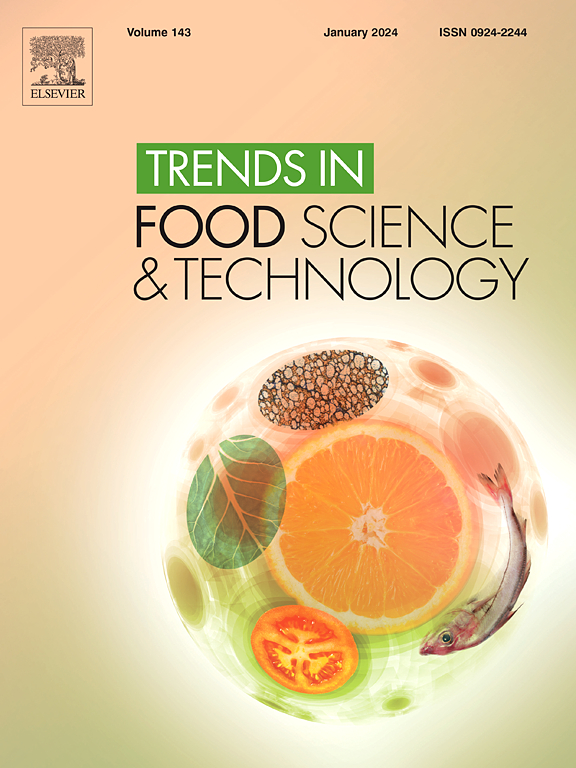共包封:增强益生菌与多酚协同作用的有效策略
IF 15.1
1区 农林科学
Q1 FOOD SCIENCE & TECHNOLOGY
引用次数: 0
摘要
益生菌和多酚类物质因其对环境的敏感性而被广泛研究。最近,由于越来越多的证据表明它们的协同作用,它们的共包合引起了人们的关注。本文综述了共封装技术及其形成机制。它强调了多酚对益生菌存活的影响,益生菌在保护和传递多酚中的作用,以及共包封对其功能的影响。对未来的展望和挑战也进行了讨论。主要发现和结论益生菌和多酚可以通过离子凝胶、喷雾干燥、复合凝聚/冷冻干燥等方法进行共包封,其机制涉及壁材/多酚与益生菌/多酚的相互作用。多酚类物质通常能提高益生菌在干燥、储存和消化过程中的存活率,而益生菌则能提高多酚类物质的稳定性和生物利用度。影响益生菌在多酚中贮藏存活的主要因素有多酚种类、浓度、益生菌菌种和贮藏温度。益生菌和多酚的共包封已被证明可以调节新陈代谢(降低血糖和脂肪吸收)并抑制结肠癌。然而,它缺乏炎症治疗。未来的研究应侧重于丰富共包覆类型,扩大益生菌对共包覆内多酚类物质的影响,探索多酚类物质作为益生菌包覆壁材料。本文章由计算机程序翻译,如有差异,请以英文原文为准。
Co-encapsulation: An effective strategy to enhance the synergistic effects of probiotics and polyphenols
Background
Probiotics and polyphenols are both widely studied for their individual encapsulation due to their environmental sensitivity. Recently, their co-encapsulation has gained attention, driven by increasing evidence of their synergistic effects.
Scope and approach
This review explores co-encapsulation technologies and their formation mechanisms. It emphasizes the effects of polyphenols on probiotic survival, the role of probiotics in protecting and delivering polyphenols, and the impact of co-encapsulation on their functionality. Future perspectives and challenges are also discussed.
Key findings and conclusions
Probiotics and polyphenols can be co-encapsulated using methods such as ionic gelation, spray drying, and complex coacervation/freeze drying, with mechanisms involving interactions of wall materials/polyphenols and probiotics/polyphenols. Polyphenols generally enhance probiotic survival during drying, storage, and digestion, while probiotics improve the stability and bioavailability of polyphenols. The main factors influencing the storage survival of probiotics in polyphenols include polyphenol type, concentration, probiotic strain, and storage temperature. Co-encapsulation of probiotics and polyphenols has been shown to regulate metabolism (reducing blood glucose and fat absorption) and inhibit colon cancer. However, it lacks inflammation treatment. Future research should focus on diversifying co-encapsulation types, expanding the influence of probiotics on polyphenols within co-encapsulation, and exploring the use of polyphenols as wall materials for probiotic encapsulation.
求助全文
通过发布文献求助,成功后即可免费获取论文全文。
去求助
来源期刊

Trends in Food Science & Technology
工程技术-食品科技
CiteScore
32.50
自引率
2.60%
发文量
322
审稿时长
37 days
期刊介绍:
Trends in Food Science & Technology is a prestigious international journal that specializes in peer-reviewed articles covering the latest advancements in technology, food science, and human nutrition. It serves as a bridge between specialized primary journals and general trade magazines, providing readable and scientifically rigorous reviews and commentaries on current research developments and their potential applications in the food industry.
Unlike traditional journals, Trends in Food Science & Technology does not publish original research papers. Instead, it focuses on critical and comprehensive reviews to offer valuable insights for professionals in the field. By bringing together cutting-edge research and industry applications, this journal plays a vital role in disseminating knowledge and facilitating advancements in the food science and technology sector.
 求助内容:
求助内容: 应助结果提醒方式:
应助结果提醒方式:


